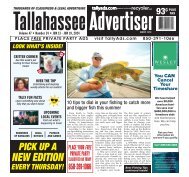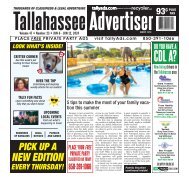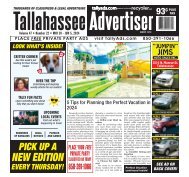Create successful ePaper yourself
Turn your PDF publications into a flip-book with our unique Google optimized e-Paper software.
Thetrucker.com BUSINESS<br />
SEPTEMBER 2023 • 17<br />
Does your ‘full coverage’<br />
insurance have you fully covered?<br />
INSURANCE<br />
INSIGHTS<br />
DEBORAH GRAVES<br />
OOIDA TRUCK INSURANCE<br />
DEPARTMENT<br />
FACTORING cont. from Page 15<br />
OOIDA truck insurance agents get calls<br />
every day from drivers who are asking for<br />
full coverage. Once the agent asks a few<br />
questions, it turns out these callers just want<br />
what is legally and contractually required.<br />
For many, “full coverage” includes<br />
Physical Damage coverage. However, most<br />
folks don’t realize that a variety of optional<br />
coverages are available, and a combination<br />
may be needed to ensure a driver is fully<br />
covered.<br />
For example, if your truck develops a<br />
mechanical problem and you end up stranded<br />
on the side of the road, there’s a coverage<br />
for that. It’s called Roadside Breakdown<br />
coverage. You could be reimbursed for the<br />
tow to the nearest qualified repair facility<br />
and/or for the labor costs of roadside<br />
assistance, up to the policy limit (parts not<br />
included).<br />
If you find you can’t operate your vehicle<br />
because of a covered loss under your Physical<br />
Damage policy, Rental Reimbursement<br />
coverage will provide reimbursement for a<br />
rental vehicle. Check with an agent about<br />
maximum coverage limits.<br />
If you haul for a shipper or motor carrier<br />
that requires you to be responsible for<br />
damage to their trailer while you are pulling<br />
it, you can add Trailer Interchange coverage.<br />
If you have an accident that results in<br />
a total loss and you find yourself upsidedown<br />
on a vehicle loan, you can put your<br />
mind at ease by opting for Gap Insurance.<br />
This coverage provides protection for the<br />
difference between a loan payoff and the<br />
market value in the event of a total loss by<br />
collision, and it’s available for both tractors<br />
and trailers.<br />
If you have a brand-new tractor and are<br />
the first owner, you might want to consider<br />
Limited Depreciation. During your first<br />
few years of ownership, your truck’s value<br />
will depreciate considerably. Limited<br />
depreciation will virtually eliminate the<br />
depreciation in the event of a covered loss.<br />
If you want your personal items protected,<br />
you should ask your agent about Personal<br />
Property coverage.<br />
You already know that being down<br />
because of an accident can cause you some<br />
financial hardship. Optional Downtime<br />
coverage provides additional protection for<br />
those times when your truck is down for<br />
repairs following a covered physical damage<br />
claim.<br />
Supplemental Towing & Clean-up<br />
coverage can help with the cost of removal of<br />
debris and cleanup of the immediate vicinity<br />
of an accident following a covered loss as<br />
well as providing coverage to tow away your<br />
truck and/or trailer.<br />
Be sure to reach out to your agent to<br />
discuss your options.<br />
You can reach an OOIDA truck insurance<br />
agent Monday through Friday, from 7:30 a.m.<br />
to 5:30 p.m. CST, at 800-715- 9369.<br />
Do you have an insurance topic you would<br />
like to know more about? If so, email us at<br />
insuranceinsights@ooida.com. We will be<br />
covering a new topic each month and will do<br />
our best to address everyone’s questions. 8<br />
to receive payment quickly instead of waiting<br />
30 to 40 days.”<br />
Smartphone technology has helped<br />
factoring grow in popularity.<br />
“Drivers find it easier to use their phones<br />
to access their information instead of going<br />
through longer processes like submitting an<br />
invoice … during a truck stop,” Hamade said,<br />
adding that more drivers are using factoring<br />
companies to manage their accounting<br />
functions, from invoicing to collections.<br />
“Thanks to factoring, truckers have more<br />
time and ease to focus their attention on<br />
other areas of the business,” Hamade said.<br />
“At RoadEx, our ‘for truckers by truckers’<br />
mantra guides how we support our customers<br />
and we’re always looking for ways to scale our<br />
services to further meet the needs of drivers,<br />
Hamade said. “As our industry navigates<br />
through a challenging trucking recession,<br />
rates are lower than ever and payments are<br />
higher, which makes it hard for drivers to<br />
have positive cash flow. RoadEx RapidPay will<br />
directly address this pain point for owneroperators<br />
who need to pay their drivers or<br />
pay for emergency repairs.”<br />
He describes RoadEx RapidPay as a “onestop<br />
shop” for owner operators.<br />
“Factoring funds can go toward a client’s<br />
insurance, or fuel without dealing with<br />
multiple vendors. Trust and transparency are<br />
key components to a great owner-operator<br />
and factoring partner relationship,” Hamade<br />
said. “At RoadEx, we have dedicated and<br />
knowledgeable account representatives, who<br />
work to help truckers get reasonable rates<br />
and top-notch customer service.”<br />
When looking for a factoring company,<br />
owner-operators should do their research<br />
and be familiar with the services provided, as<br />
well as the company’s reputation.<br />
“Whether it’s hidden fees or the amount of<br />
time it takes to receive funds, it’s important<br />
for owner-operators to do their research on<br />
a factoring company by checking reviews<br />
and making calls,” Hamade said. “Doing the<br />
research prior to a contract commitment<br />
will help trucking companies find the right<br />
factoring partner to support their business.”<br />
8<br />
FLEETWORTHY CLOSE-UP<br />
Human interaction is key for successful use of ELDs<br />
An electronic logging device (ELD) is the<br />
best tool available to capture HOS data<br />
and measure against the HOS minimums<br />
set by the Federal Motor Carrier Safety Administration<br />
(FMCSA). These devices are<br />
relied on heavily in our industry to act as<br />
the de facto HOS clock, referred to in audits,<br />
roadside inspections and litigation.<br />
HOS rules are specific, and are expected<br />
to be followed. Because of this, ELD manufacturers<br />
design their devices so that the<br />
required information can easily be accessed<br />
by fleet operators as well as law<br />
enforcement.<br />
FALSE SENSE OF SECURITY?<br />
But what if that ELD is not painting an<br />
accurate picture of compliance or risk and<br />
instead is providing a false sense of security<br />
for your fleet? Are you depending on<br />
your ELD to manage your HOS, or are you<br />
an active participant in the process? There<br />
is no doubt ELDs make it easier to track<br />
HOS data — however, that data still needs<br />
to be analyzed and managed by a safety<br />
professional.<br />
According to the CSA enforcement program,<br />
HOS violations in 2022 accounted<br />
for three of the Top 10 violations resulting<br />
in out-of-service (OOS) orders, including<br />
No Logs When Required (No. 2) and<br />
False Logs (No. 3). The top HOS violations<br />
include exceeding the 11- or 14-hour limits,<br />
not taking 10 hours off and false logs.<br />
These statistics reveal that management<br />
is relying too heavily on ELDs and should<br />
start manually reviewing logs daily and<br />
hold their drivers accountable for following<br />
HOS rules.<br />
HAVE ELDS IMPROVED SAFETY?<br />
This is a hard question to answer because<br />
of factors such as the COVID-19<br />
pandemic, which resulted in several HOS<br />
exceptions, as well as the HOS changes<br />
made in 2020. However, if you look at the<br />
most recent data (October 2022) published<br />
by the FMCSA regarding crashes<br />
involving fatality or injury, it shows ELDs<br />
are not effective as “safety devices” on<br />
their own. In fact, rates for “accidents by<br />
100 million miles” have actually increased<br />
since the ELD mandate went into effect in<br />
2017. In 2019, this figure actually increased<br />
10% from 2016 — the year before the ELD<br />
mandate was enforced.<br />
This proves that relying strictly on ELD<br />
data is not an effective HOS management<br />
tool for your company or the public safety.<br />
Considering the cost of implementing<br />
these devices, one would expect to have<br />
an ROI that can be pointed to, specific to<br />
reduction in accidents/injuries/fatalities.<br />
Instead, an increase in accidents, risk<br />
and significant lawsuits have proliferated<br />
SPONSORED CONTENT<br />
as indicated in the average size of verdicts<br />
since the ELD mandate went into effect.<br />
According to a study by the American<br />
Transportation Research Institute (ATRI),<br />
HOS was a significant factor in 95% of “nuclear”<br />
verdict cases. In many of these cases,<br />
the driver’s HOS were clearly in violation,<br />
and the motor carrier was found to be responsible<br />
and/or negligent.<br />
MANAGE THE DATA<br />
How a motor carrier manages their drivers’<br />
ELD compliance — including reports,<br />
trends and data output — is critical to going<br />
beyond the minimum requirements<br />
while not falling victim to complacent<br />
compliance. Are you equipped to manage<br />
all elements of the FMCSA’s HOS compliance<br />
regulations without assistance? If an<br />
audit is called tomorrow, how confident<br />
are you that you’d receive a satisfactory<br />
rating? Would your feeling of confidence<br />
increase knowing you had a partner in<br />
compliance that has the experience and<br />
tools needed to provide support?<br />
Fleetworthy Solution’s team of subject<br />
matter experts and their intelligent compliance<br />
platform, CPSuite, can decipher all<br />
the information coming from your ELDs,<br />
identify trends and actionable data, and<br />
provide recommendations to improve<br />
your safety department and your overall<br />
standing within the HOS Basic.. Each<br />
driver’s HOS records are at your fingertips,<br />
along with the ability to manage other<br />
safety-regulated and risk-minimizing requirements<br />
such as DVIR/EVIR, maintenance<br />
records and driver qualification<br />
records.<br />
Having these resources at your disposal<br />
allows you to focus on the right areas and<br />
free up time to maintain the personal interaction<br />
needed with one of your most<br />
valuable resources — your drivers. With<br />
Fleetworthy Solutions, you’ll go beyond<br />
the minimum standards of compliance.<br />
Reach out for a demo of our industry<br />
leading products and services and see for<br />
yourself what going “Beyond Compliant”<br />
can do for your organization. Together, we<br />
can help minimize the number of daily accidents<br />
one driver at a time!<br />
For information, visit fleetworthy.com<br />
or email marketing@fleetworthy.com.

















